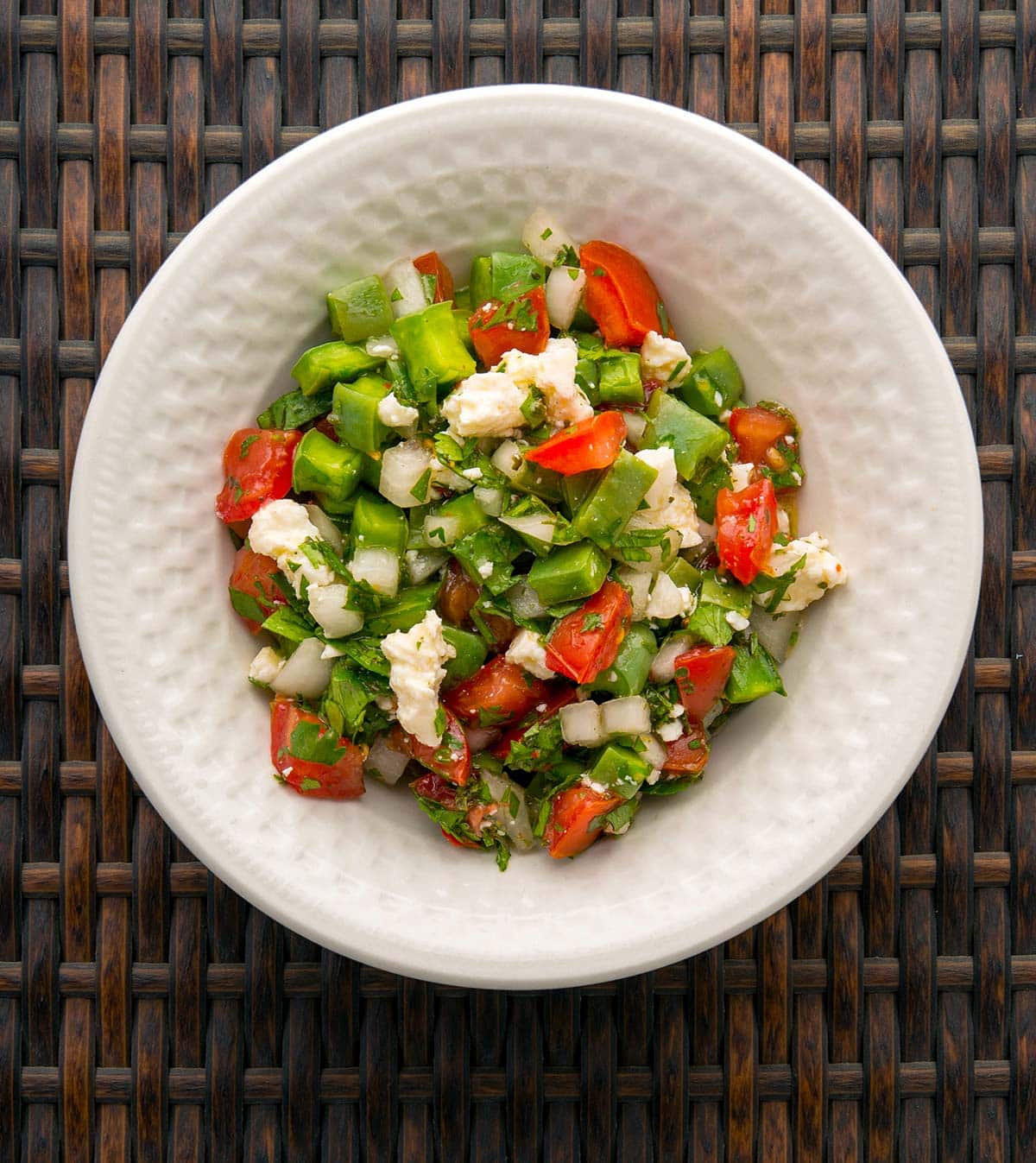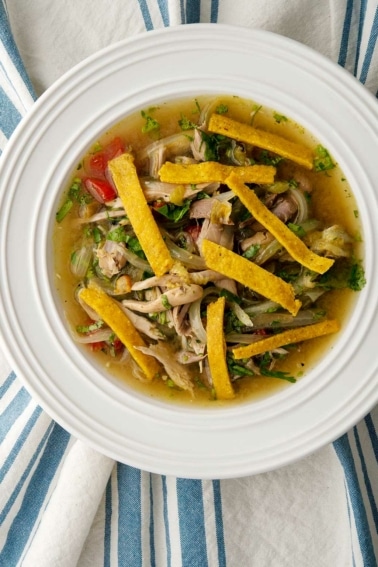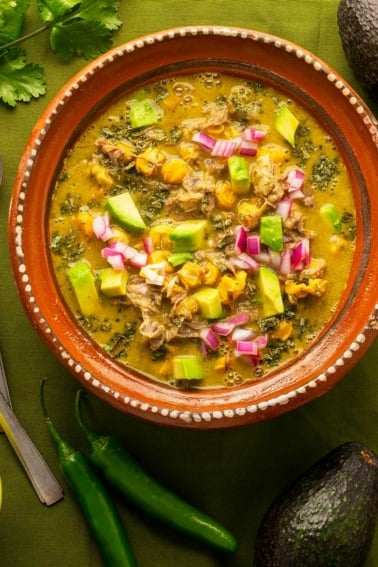As an Amazon Associate I earn from qualifying purchases.
No nation eats more cactus than Mexico, and you will see it most often as ensalada de nopales, cactus salad.
I know to many this sounds weird. Aren’t cacti spiny and awful? Indeed they are. But once you know how to clean nopales, as they are called in Spanish, you are good to go.

Keep in mind I am talking about the paddles from the various species of opuntia cactus, the prickly pears or beavertail cacti. The paddles of all species are edible, but they are best eaten when young and tender, nopalitos in Spanish.
Some species of prickly pear grows pretty much everywhere from Canada to South America. There are cultivated varieties with fewer spines or larger paddles. I bought a few from my local farmers market years ago and now, every spring, it’s nopales season. They only set new paddles in spring where I live, and this will be true in most places, although in the desert and in Mexico they will set after significant rain.
Why bother? Aside from the fact that nopales are super nutritious and are apparently a good thing to eat if you have diabetes. I eat them because they taste good. Imagine a lemony, crunchy green bean.
What about the nopales’ legendary slime? The babas, a slime worthy of Ghostbusters? Yes, it’s true. But there are a lot of ways to remove the slime from nopales. Incidentally, a single paddle is called a nopal, just as a single dumpling in a batch of tamales is called a tamal.
Many recipes for ensalada de nopales will have you cook your nopales to remove the slime. This is perfectly OK and if that’s how you like your cactus salad, go for it. I, however, prefer to eat them raw. The flavor is brighter and nicer.
I learned the method of removing the slime from raw nopales in the awesome cookbook Nopalito: A Mexican Kitchen. Dice the paddle as you want to later eat it, then toss with a fair bit of fine salt — fine salt is important because it draws out the slime better — let it sit and then rinse, rinse, rinse. Doneski.
After that, toss with the standard “Mexican salad” ingredients — you know it as pico de gallo — of diced tomatoes, white onion soaked in lime juice, a little Mexican oregano, cotija or feta cheese, a chile or six, and lots of cilantro. You can add a touch of olive oil if you want, too.
Ensalada de nopales is a healthy, tasty, easy salad to make that is a bit different from what you might be used to. After all, 126 million Mexicans can’t be wrong!
If you want to make this a cactus feast, I’d add either a nopales tacos or nopales en escabeche, a cool pickled nopales recipe that you could also put in your tacos.
Ensalada de Nopales, Cactus Salad
Ingredients
- 4 nopales paddles, despined
- Fine grain salt
- 4 plum tomatoes, seeded and diced
- 1/2 white onion, chopped
- 1/4 cup lime juice
- 2 serrano or jalapeno chiles, seeded and minced
- 1 teaspoon Mexican oregano (regular oregano is fine)
- 1 tablespoon olive oil
- 1/4 cup chopped cilantro
- 1/2 cup crumbled cotija or feta cheese
- 1 avocado, diced (optional)
Instructions
- Dice the nopales and toss with salt. You want all the cut sides of the nopales to have salt on them. Put them in a colander in the sink and let this drain for 1 hour. When the time has elapsed, rinse the nopales under cold water until they are no longer slimy, which should take maybe 3 to 5 minutes. Pat dry with a kitchen towel put into a large bowl.
- While the nopales are sitting in the colander, mix the diced onion with a little salt and the lime juice and let them pickle a bit. This takes the harsh edge off the raw onion. If you want, you can add the minced chiles to the lime juice, too.
- When you're ready, mix all the ingredients together and serve.
Nutrition
Nutrition information is automatically calculated, so should only be used as an approximation.







I love this recipe so much! It tastes just like the cactus salad that I get at a food truck in Austin. Eating these raw is the secret to making this dish great, but you really do have to salt and rinse, rinse, rinse the snot out. I grow a spineless variety that is especially thick, crispy, and sour; But any variety will work. I added tomatillos in addition to the plum tomatoes.
I am lucky that I can buy despined nopales at my farmers market. I prefer them cooked, and also I am not into slime, so I follow the advice I got at the farmers’ market – I grill them briefly. If they don’t touch water, they don’t produce slime . Then I cut them up for salads.
Hi Hank
Lots of people don’t know how to remove the thorns from nopales. How do you do it?
Anna: Like this: https://honest-food.net/how-to-clean-nopales/
I had a delicious nopales salad in Mexico City years ago. It was served with tiny dried fish as a garnish. I have never seen that offered in any restaurant here in the states. I guess I must make a visit to the neighbors and harvest a few paddles and experiment. Only issue is tomatoes right now for the mega markets are all picked green and force ripened and are terrible.
Curt: I have a hack for the tomato problem: Buy Roma (plum) tomatoes many days before you want to eat them raw. Let them ripen on your kitchen table at room temperature until they are almost wrinkly on the outside, or at least three days. Works like a charm.
I’ve been eating lots of nopales lately. Despining is the main barrier. Use gloves and or tongs to handle the paddles. After years of scraping following by splinter removal. I’ve discovered that it’s easiest to burn off the almost invisible glochids with my culinary torch.
Debbie: That’s what I do, too.
So excited to get this! I have loved Nopales when in Mexico and along our border, but never when I prepared them. They put okra to shame when it comes to slime. Plan on trying this this weekend as they are available in the market here.